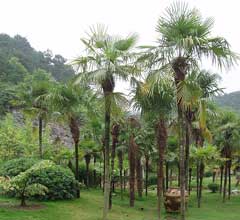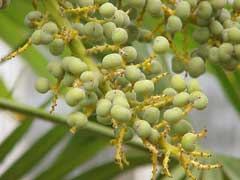 |
|
commons.wikimedia.org/wiki/User:Fanghong |
 |
| biolib.de |
Translate this page:
Summary
Bloom Color: White, Yellow. Main Bloom Time: Early summer, Late summer, Mid summer. Form: Palm, Upright or erect.
Physical Characteristics

 Trachycarpus fortunei is an evergreen Tree growing to 12 m (39ft) by 2 m (6ft) at a slow rate.
Trachycarpus fortunei is an evergreen Tree growing to 12 m (39ft) by 2 m (6ft) at a slow rate.
See above for USDA hardiness. It is hardy to UK zone 8. It is in leaf all year, in flower from August to September. The species is dioecious (individual flowers are either male or female, but only one sex is to be found on any one plant so both male and female plants must be grown if seed is required). and is pollinated by Insects. The plant is not self-fertile.
Suitable for: light (sandy), medium (loamy) and heavy (clay) soils. Suitable pH: mildly acid, neutral and basic (mildly alkaline) soils. It can grow in semi-shade (light woodland) or no shade. It prefers moist soil.
UK Hardiness Map
US Hardiness Map
Synonyms
T. excelsus. Chamaerops fortunei. C. excelsus.
Habitats
Woodland Garden Sunny Edge; Dappled Shade;
Edible Uses
Edible Parts: Flowers Shoots
Edible Uses:
Young flower buds - cooked[2, 105, 178]. Used like bamboo shoots[183]. The fresh flowers and terminal bud are also apparently consumed[183].
References More on Edible Uses
Medicinal Uses
Plants For A Future can not take any responsibility for any adverse effects from the use of plants. Always seek advice from a professional before using a plant medicinally.
Astringent Contraceptive Haemostatic
The flowers and the seed are astringent and haemostatic[147, 218]. The root or the fruit is decocted as a contraceptive[147, 218]. The ashes from the silky hairs of the plant are haemostatic[147, 218]. Mixed with boiling water they are used in the treatment of haemopytsis, nose bleeds, haematemesis, blood in stools, metrorrhagia, gonorrhoea and other venereal diseases[147].
References More on Medicinal Uses
Now available: PLANTS FOR YOUR FOOD FOREST: 500 Plants for Temperate Food Forests and Permaculture Gardens.
An important new book from PFAF. It focuses on the attributes of plants suitable for food forests, what each can contribute to a food forest ecosystem, including carbon sequestration, and the kinds of foods they yield. The book suggests that community and small-scale food forests can provide a real alternative to intensive industrialised agriculture, and help to combat the many inter-related environmental crises that threaten the very future of life on Earth.
Read More
Other Uses
Fibre Weaving
The fibres cloaking the trunk are used to make ropes and cloth[11, 46, 61]. The fibres from within the leafstalk are used for making brushes, ropes, coarse cloth etc[231]. A matting is made from the bark admixed with some of the stem fibres[178]. The leaves are woven into hats, rough coats and fans[46, 61, 178].
Special Uses
Carbon Farming Scented Plants
References More on Other Uses
Cultivation details
Industrial Crop: Fiber Industrial Crop: Wax Management: Standard Regional Crop
Landscape Uses:Border, Container, Specimen, Woodland garden. Requires a rich moist but well-drained soil in a sunny sheltered position[188, 231], especially from the cold drying winds of the north and east[11]. Individual leaves live for about 3 years and, if they are damaged by wind will make the plant look very shabby as well as reducing its potential for photosynthesis[231]. This species is generally hardy in the southern and western part of Britain. When mature, plants have been known to survive occasional temperatures as low as -18°c[11, 231, 260] though younger plants are more tender and can be damaged by temperatures down to about -8°c, especially if the plant is not sheltered from cold winds[200, 260].Very young plants should be given some protection during their first winter or two outdoors[11] . A fairly slow-growing plant, though it self-sows in S.W. England[11]. Widely cultivated throughout China, Japan and S.E. Asia for the fibres within the leaf stalk[231]. Palms usually have deep penetrating root systems and generally establish best when planted out at a young stage. However, older plants are substantially more cold tolerant than juvenile plants[231]. In areas at the limit of their cold tolerance, therefore, it is prudent to grow the plants in containers for some years, giving them winter protection, and only planting them into their permanent positions when sheer size dictates[231]. Palms can also be transplanted even when very large. Although the thick fleshy roots are easily damaged and/or desiccated, new roots are generally freely produced. It is important to stake the plant very firmly to prevent rock, and also to give it plenty of water until re-established - removing many of the leaves can also help[231]. The flowers are sweetly scented[231]. Dioecious. Male and female plants must be grown if seed is required. Special Features:Attractive foliage, Not North American native, Fragrant flowers, Inconspicuous flowers or blooms.
Carbon Farming
-
Industrial Crop: Fiber
Clothing, rugs, sheets, blankets etc. Currently, almost none of our fiber are produced from perennial crops but could be!
-
Industrial Crop: Wax
Water resistant, malleable substances. Currently, most commercial wax is made from paraffin - a fossil fuel.
-
Management: Standard
Plants grow to their standard height. Harvest fruit, seeds, or other products. Non-Destructive management systems.
-
Regional Crop
These crops have been domesticated and cultivated regionally but have not been adopted elsewhere and are typically not traded globally, Examples in this broad category include perennial cottons and many nuts and staple fruits.
References Carbon Farming Information and Carbon Sequestration Information
Temperature Converter
Type a value in the Celsius field to convert the value to Fahrenheit:
Fahrenheit:
The PFAF Bookshop
Plants For A Future have a number of books available in paperback and digital form. Book titles include Edible Plants, Edible Perennials, Edible Trees, and Woodland Gardening. Our new book to be released soon is Edible Shrubs.
Shop Now
Propagation
Scarify or pre-soak the seed for 24 hours in warm water then sow in a cold frame in mid to late winter. Bring into the greenhouse about 4 - 6 weeks later and the seed should germinate in about 4 - 8 weeks at 25°c[133]. As soon as they are large enough to handle, prick the seedlings out into individual pots and grow them on in the greenhouse for at least their first winter. Plant them out into their permanent positions in late spring or early summer, after the last expected frosts. Consider giving the plants some protection from the cold for at least their first winter outdoors. Pot up suckers in late spring and plant out in their permanent position 12 months later.
Other Names
If available other names are mentioned here
Native Plant Search
Search over 900 plants ideal for food forests and permaculture gardens. Filter to search native plants to your area. The plants selected are the plants in our book 'Plants For Your Food Forest: 500 Plants for Temperate Food Forests and Permaculture Gardens, as well as plants chosen for our forthcoming related books for Tropical/Hot Wet Climates and Mediterranean/Hot Dry Climates. Native Plant Search
Found In
Countries where the plant has been found are listed here if the information is available
Weed Potential
Right plant wrong place. We are currently updating this section.
Please note that a plant may be invasive in one area but may not in your area so it’s worth checking.
Conservation Status
IUCN Red List of Threatened Plants Status :

Growth: S = slow M = medium F = fast. Soil: L = light (sandy) M = medium H = heavy (clay). pH: A = acid N = neutral B = basic (alkaline). Shade: F = full shade S = semi-shade N = no shade. Moisture: D = dry M = Moist We = wet Wa = water.

Expert comment
Author
(Hook.)H.Wendl.
Botanical References
11200
Links / References
For a list of references used on this page please go here
Readers comment